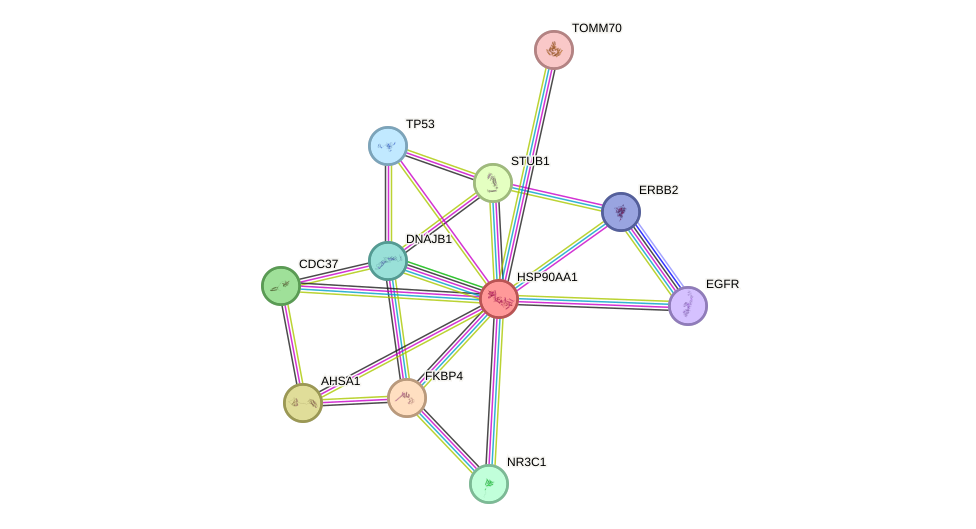GenAge entry for HSP90AA1 (Homo sapiens)
Gene name (HAGRID: 74)
- HGNC symbol
- HSP90AA1
- Aliases
- Hsp89; Hsp90; FLJ31884; HSP90N; HSPC1; HSPCA
- Common name
- heat shock protein 90kDa alpha (cytosolic), class A member 1
Potential relevance to the human ageing process
- Main reason for selection
- Entry selected based on evidence linking the gene product to a pathway or mechanism linked to ageing
- Description
Also known as Hsp90, HSP90AA1 is a molecular chaperone. Similar proteins have been suggested to impact on the ageing process of model organisms [632]. HSP90AA1 is affected by ageing in rats [909], though no evidence has directly linked HSP90AA1 to human ageing.
Cytogenetic information
- Cytogenetic band
- 14q32.33
- Location
- 102,080,738 bp to 102,087,175 bp
- Orientation
- Minus strand
Protein information
- Gene Ontology
-
Process: GO:0000086; G2/M transition of mitotic cell cycle
GO:0006839; mitochondrial transport
GO:0006898; receptor-mediated endocytosis
GO:0006986; response to unfolded protein
GO:0007165; signal transduction
GO:0009408; response to heat
GO:0009409; response to cold
GO:0018108; peptidyl-tyrosine phosphorylation
GO:0031396; regulation of protein ubiquitination
GO:0038096; Fc-gamma receptor signaling pathway involved in phagocytosis
GO:0038128; ERBB2 signaling pathway
GO:0042026; protein refolding
GO:0043254; regulation of protein complex assembly
GO:0043335; protein unfolding
GO:0045040; protein import into mitochondrial outer membrane
GO:0045429; positive regulation of nitric oxide biosynthetic process
GO:0046677; response to antibiotic
GO:0048010; vascular endothelial growth factor receptor signaling pathway
GO:0050821; protein stabilization
GO:0050999; regulation of nitric-oxide synthase activity
GO:0051131; chaperone-mediated protein complex assembly
GO:0061684; chaperone-mediated autophagy
GO:1900034; regulation of cellular response to heat
Cellular component: GO:0005576; extracellular region
GO:0005634; nucleus
GO:0005654; nucleoplasm
GO:0005737; cytoplasm
GO:0005829; cytosol
GO:0005886; plasma membrane
GO:0016020; membrane
GO:0032587; ruffle membrane
GO:0042470; melanosome
GO:0043202; lysosomal lumen
GO:0043209; myelin sheath
GO:0070062; extracellular exosome
GO:0071682; endocytic vesicle lumen
Hide GO termsFunction: GO:0000166; nucleotide binding
GO:0004713; protein tyrosine kinase activity
GO:0005515; protein binding
GO:0005524; ATP binding
GO:0016887; ATPase activity
GO:0023026; MHC class II protein complex binding
GO:0030235; nitric-oxide synthase regulator activity
GO:0030911; TPR domain binding
GO:0042802; identical protein binding
GO:0042803; protein homodimerization activity
GO:0042826; histone deacetylase binding
GO:0044822; poly(A) RNA binding
GO:0051020; GTPase binding
GO:0051082; unfolded protein binding
GO:1990782; protein tyrosine kinase binding
Protein interactions and network
- Protein-protein interacting partners in GenAge
- SHC1, TP53, TERT, IGF1R, STAT3, AKT1, MYC, EGFR, ERBB2, PDGFRB, PRKCD, PPARA, RET, BRCA1, PTEN, HIF1A, BLM, BCL2, HSP90AA1, VEGFA, ABL1, RAD51, STK11, GSK3B, PRKCA, EEF2, TERF1, PRKDC, AR, TERF2, HSPA8, GRB2, HSF1, FOXM1, UCHL1, APP, RAD52, SIRT1, HSPA1A, HSPA1B, PTK2B, PTK2, FGFR1, SP1, JUN, MAP3K5, EEF1A1, ATF2, JAK2, HSPA9, SIN3A, CDK1, MAX, MDM2, VCP, H2AFX, NR3C1, ESR1, CDKN2A, ATR, STUB1, ARNTL, CDKN1A, MIF, GSK3A, IKBKB, CDK7
- STRING interaction network
Retrieve sequences for HSP90AA1
Homologs in model organisms
- Caenorhabditis elegans
- daf-21
- Danio rerio
- hsp90aa1.2
- Mus musculus
- Hsp90aa1
- Rattus norvegicus
- Hsp90aa1
In other databases
- CellAge
- This gene is present as HSP90AA1

